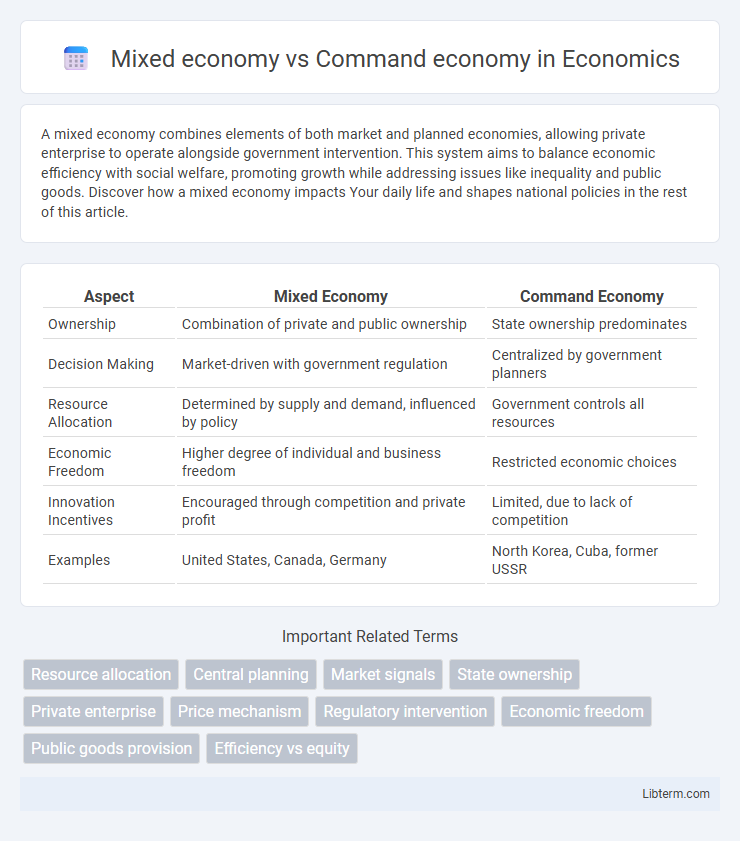A mixed economy combines elements of both market and planned economies, allowing private enterprise to operate alongside government intervention. This system aims to balance economic efficiency with social welfare, promoting growth while addressing issues like inequality and public goods. Discover how a mixed economy impacts Your daily life and shapes national policies in the rest of this article.
Table of Comparison
| Aspect | Mixed Economy | Command Economy |
|---|---|---|
| Ownership | Combination of private and public ownership | State ownership predominates |
| Decision Making | Market-driven with government regulation | Centralized by government planners |
| Resource Allocation | Determined by supply and demand, influenced by policy | Government controls all resources |
| Economic Freedom | Higher degree of individual and business freedom | Restricted economic choices |
| Innovation Incentives | Encouraged through competition and private profit | Limited, due to lack of competition |
| Examples | United States, Canada, Germany | North Korea, Cuba, former USSR |
Introduction to Economic Systems
Mixed economy blends market freedom with government intervention, balancing private enterprise and public regulation to promote economic efficiency and social welfare. Command economy relies on centralized government control to allocate resources and direct production, emphasizing public ownership and planned distribution of goods and services. These contrasting systems illustrate fundamental approaches to managing economic activity and addressing societal needs.
Defining Mixed Economy
A mixed economy combines elements of both market and command economies, allowing private enterprise alongside government regulation and public sector involvement. It balances economic freedom with government intervention to correct market failures and promote social welfare. This system aims to optimize resource allocation while addressing inequalities and ensuring economic stability.
Defining Command Economy
A command economy is an economic system where the government centrally plans and controls all major economic activities, including production, distribution, and pricing of goods and services. This system contrasts with a mixed economy, where both government intervention and private enterprise coexist, allowing market forces to influence resource allocation alongside regulatory oversight. Command economies prioritize state ownership and aim to achieve equal distribution of wealth and resources, often limiting individual economic freedoms.
Key Features of Mixed Economies
Mixed economies combine elements of both market and command economies, featuring private enterprise alongside significant government intervention to regulate and stabilize the market. Key features include a balance between free-market capitalism and public sector control, allowing for efficient resource allocation while addressing social welfare and economic inequalities. This system supports competition and entrepreneurship within a regulatory framework that provides public goods and enforces labor and environmental standards.
Core Characteristics of Command Economies
Command economies are characterized by centralized government control over all major economic activities, including the production and distribution of goods and services. Resource allocation, pricing, and investment decisions are dictated by a central authority rather than market forces, aiming to achieve government-established goals such as equitable wealth distribution and stability. This system often limits private enterprise and consumer choice, emphasizing collective societal objectives over individual profit.
Role of Government in Both Economies
In a mixed economy, the government plays a regulatory role by intervening to correct market failures, provide public goods, and ensure economic stability while allowing private enterprises to operate freely. In contrast, a command economy features extensive government control over production, distribution, and resource allocation, with centralized planning dictating economic activities. The degree of government involvement is the key differentiator, influencing efficiency, innovation, and individual economic freedom.
Advantages of Mixed Economy
A mixed economy combines the efficiency of market-driven enterprises with government regulation to ensure social welfare and reduce inequality. This system allows for private ownership and competition while enabling state intervention in critical sectors, promoting economic stability and public goods provision. The adaptability of mixed economies fosters innovation, balanced growth, and protection against market failures compared to purely command-based economies.
Strengths of Command Economy
A command economy offers strong centralized control, enabling rapid mobilization of resources and streamlined decision-making to meet national goals. It effectively eliminates market uncertainties by dictating production and distribution, ensuring stability and equitable access to essential goods and services. This system also facilitates long-term planning, which can foster large-scale infrastructure projects and social welfare programs without reliance on profit motives.
Challenges and Criticisms of Each System
Mixed economies face challenges in balancing government intervention with market freedom, often resulting in inefficiencies, regulatory complexities, and potential corruption. Command economies struggle with resource allocation errors, lack of incentives for innovation, and inefficiencies caused by centralized decision-making. Both systems encounter criticism for either excessive bureaucracy or insufficient economic freedoms, impacting overall growth and social welfare.
Mixed Economy vs Command Economy: Comparative Analysis
A mixed economy balances private enterprise with significant government intervention, promoting both market freedom and social welfare, whereas a command economy relies entirely on centralized government planning and control of resources. Mixed economies typically encourage innovation and efficiency through competition while maintaining regulations to correct market failures, in contrast to command economies which often face inefficiencies due to lack of market signals and centralized decision-making. Comparative analysis reveals that mixed economies adapt more dynamically to economic changes, driving growth and consumer choice, whereas command economies prioritize equitable distribution and stability but may struggle with resource allocation and incentives.
Mixed economy Infographic

 libterm.com
libterm.com